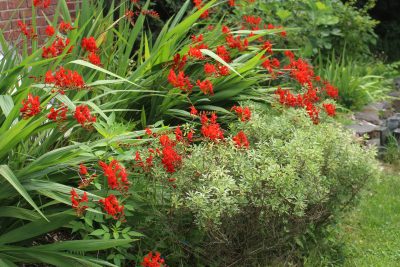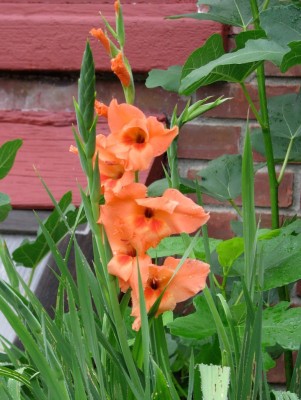Of Crocs and Glads
No-Dig Crocs
Plants grow and multiply, which sometimes causes trouble. Such trouble was highlighted this week as I was digging up my crocosmia bulbs.
 Backpedaling perhaps 20 years, you would have found me ordering crocosmia bulbs from a mail-order catalog. I’d seen the plants blooming in a friend’s garden in New Jersey and marveled at the graceful flower stems that arched up and out from clumps of sword-shaped leaves. Lined up near the ends of each flower stalk were pairs of tubular, hot scarlet blossoms.
Backpedaling perhaps 20 years, you would have found me ordering crocosmia bulbs from a mail-order catalog. I’d seen the plants blooming in a friend’s garden in New Jersey and marveled at the graceful flower stems that arched up and out from clumps of sword-shaped leaves. Lined up near the ends of each flower stalk were pairs of tubular, hot scarlet blossoms.
Crocosmia isn’t supposed to be cold-hardy outdoors where winter temperatures drop below minus 10 degrees F. (hardiness zone 5), so the first couple of autumns, as instructed, I dug up the bulbs for winter storage. Each spring following, the plants would get off to a slow start, finally blooming late in the season or not at all.
In disappointment or laziness, I stopped digging the bulbs up each fall. I was surprised to see them appear in spring anyway. Not only did they appear in spring; they had some real oomph, growing almost as luxuriantly as the ones in my friend’s garden. To make matters better, they started blooming earlier, in July, and in great profusion, and they have done so reliably year after year with no help at all from me.
The crocosmias also multiplied, and they did so with such enthusiasm that there became just too many of them at the original location. So I started digging. And I uncovered bulb after bulb after bulb, ready to bloom and multiply next year. Now I have to decide what to do with all those bulbs. Plant them? Give them away? Compost them? I would have never thought I could have had too many crocosmias.
Glads Won’t Die
Does anybody around here still dig up their gladiolas each fall? I don’t, but to no avail. Left outside, they still survive every winter. Yuk. (Gladiolus “bulbs” are, like crocosmia “bulbs,” actually bulb like structured called “corms.”)
I don’t like gladiolas. Perhaps it’s because they are the most popular flower for funerals.
At any rate, I did, for some reason, plant some glads over 30 years go, glads whose beautiful salmon, pink color I subsequently felt was wasted on glad flowers. The nice color couldn’t outweigh the funereal associations, so after a couple of years of digging them up for storage each fall, I decided to sacrifice them to winter cold.
Unfortunately, they reappeared each year, and have continued to do so annually. I have to chuckle whenever I read instructions such as: “Corms should be dug after foliage has matured and started turning brown. Lift corms carefully with a spade or spading fork, taking care not to cut into the corm. Cut the tops off 1inch above the corm and dry for 2 to 4 weeks in a warm location (70-80 degrees Fahrenheit) with good air circulation. Remove the old corm which is beneath the new corm. Discard any rotted or damaged corms. Cut stems back to within an eighth of an inch of the corm. Place the corms in an onion sack or old nylon panty hose. Hang from a wall or ceiling. Ideal storage temperatures are between 35 and 40 degrees Fahrenheit.”
Hah! Doing nothing at all has, unfortunately, worked fine for me. At least the gladiolas haven’t multiplied as fast as the crocosmias.
Cold Air, Not So Cold Soil
The whole concept of winter hardiness for a plant only whose roots (or corms, in the case of crocosmia and gladiola) need to survive winter is hazy. After all, three feet down in the soil almost everywhere, temperatures hover around 50 degrees Fahrenheit.
Lay some mulch on top of any soil and penetration of winter cold can’t reach as deeply as through bare soil or lawn. Bare soil doesn’t peek out anywhere in my garden. Whatever is not lawn has been mulched year after year for many years with leaves, wood chips, sawdust, compost, hay, or whatever other organic materials I can get my hands on. (No, my garden isn’t three feet higher than it was when I started because those organic mulches decompose, enriching the soil as they do so.)
Nonetheless, the ground that the crocosmias and glads call home is well-insulated from winter cold. Warmer winters for the past few years have also helped these “nonhardy” bulbs survive outdoors, especially the less cold-hardy gladiolus.

